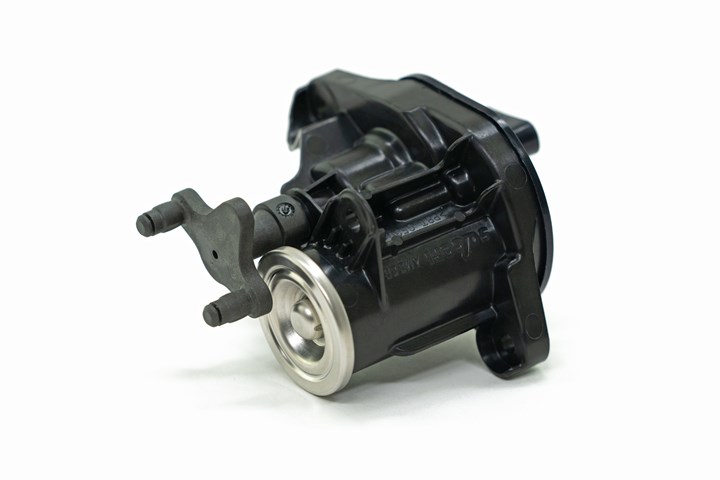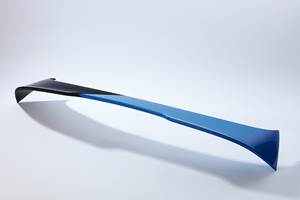Hydrolysis-Resistant PBT that is Also Laser Transparent 'Shines' in Demanding Automotive Engine Application
Actuators for new automotive diesel engine series made with a Lanxess PBT that is hydrolylis-stabilized and allows for laser transmission welding.
Not all PBT’s are created equal—particularly those used for demanding automotive applications, such as optimized combustion process swirl control actuators, part of the air management systems in combustion engines responsible for controlling the air supply to the intake module and, at the same time, ensuring sufficient air turbulence. Such actuators help to optimize combustion processes and so play a key role in ensuring that the engine is highly efficient, which is ultimately reflected in high fuel economy and correspondingly low consumption figures.
We recently heard from Lanxess regarding the use of one of its specialty PBT compounds that was selected by a German automotive manufacturer for a new automotive diesel engine series. PBTs are generally used for such actuators because of their dimensional stability. But, since an actuator can also be exposed to a hot and humid climate in the engine compartment, a hydrolysis-stabilized material is required. In this particular application, laser transmission welding (a major trend in plastic housings) was selected as the joining method because it produces strong, lint-free and tight welds.

However, the combination of hydrolysis resistance and laser transparency is a conflicting target on the material side. “As such, our Pocan B3233HRLT is already something very special with which we can serve this trend,” said Jean-Marie Olivé, an application development expert in Lanxess’ High Performance Materials (HPM) business unit. The actuators are developed and manufactured by Sogefi Air & Cooling SAS in Orbey, France. The company is part of Sogefi S.p.A., an Italian corporate group that is among the world’s leading providers of filter systems, flexible chassis components and air intake and engine cooling systems for vehicles.
In principle, a 30% glass-reinforced nylon 6 or a non-laser transmissible (LT) 30% glass-reinforced PBT would also be conceivable. However, nylon is less dimensionally stable due to moisture absorption, and in the case of non-LT PBT, one would have to switch to a less modern joining process, e.g. screwing with a seal or ultrasonic welding (lower weld seam strength, lint formation).
“The special feature of this application is certainly modern laser transmission welding. This is already something special with our PBT HR materials, since normally the transparency is not sufficient to achieve a good weld seam. In addition, we have a laser-transparent black here, which not everyone can do either. Normally, soot-filled black components absorb the laser radiation completely, so that no transmission welding is possible,” explained Olivé.
Laser transmission welding is ideally suited to the cost-effective and gentle production of very small components with complex geometries, making it perfect for the trend toward miniaturized electrical and electronic functions. The procedure uses the energy of laser light. A laser beam passes through a laser-transparent component and is absorbed by a second component – usually black-pigmented – underneath. The absorption creates heat, which melts the surface of the second component. In turn, heat conduction softens the surface of the first component, allowing a strong weld seam to form between the two components. In the case of the new actuator, the laser transparent part is made from Pocan B3233HRLT with laser transparent black coloring, while the absorbing housing half is made from Pocan B3233HR.
The outstanding resistance of B3233HRLT to hot and humid environments is demonstrated in the SAE/USCAR-2 Rev. 6 long-term test, which is conducted in accordance with a standard set by the American Society of Automotive Engineers (SAE) and considered to be among the world’s most demanding tests of the hydrolysis stability of plastics. A finished part is exposed to strong temperature changes at relative humidities of up to 100% over numerous cycles.
Said Olivé, “In specimen tests conducted in similar conditions, our compound fulfills the requirements of Class 3 and so can withstand temperatures up to 125 C/257 F.”
Related Content
K 2022 Preview: Engineering Materials for Sustainability and E-Mobility
Materials that are sustainable yet offer equal performance to their fossil-based counterparts will be prominent at K 2022.
Read MoreSPE Automotive Awards Applaud ‘Firsts’ and Emerging Technologies
The 51st annual SPE Automotive Innovation awards gave nods to several ‘firsts’ and added alternative vehicle systems category.
Read MoreDesign Optimization Software Finds Weight-Saving Solutions Outside the Traditional Realm
Resin supplier Celanese turned to startup Rafinex and its Möbius software to optimize the design for an engine bracket, ultimately reducing weight by 25% while maintaining mechanical performance and function.
Read MoreMolder Repairs Platen Holes with Threaded Inserts
Automotive molder ITW Deltar Fasteners found new life for the battered bolt holes on its machine platens with a solution that’s designed to last.
Read MoreRead Next
Lead the Conversation, Change the Conversation
Coverage of single-use plastics can be both misleading and demoralizing. Here are 10 tips for changing the perception of the plastics industry at your company and in your community.
Read MoreRecycling Partners Collaborate to Eliminate Production Scrap Waste at NPE2024
A collaboration between show organizer PLASTICS, recycler CPR and size reduction experts WEIMA and Conair will seek to recover and recycle 100% of the parts produced at the show.
Read MoreFor PLASTICS' CEO Seaholm, NPE to Shine Light on Sustainability Successes
With advocacy, communication and sustainability as three main pillars, Seaholm leads a trade association to NPE that ‘is more active today than we have ever been.’
Read More









 (2).jpg;maxWidth=300;quality=90)
















